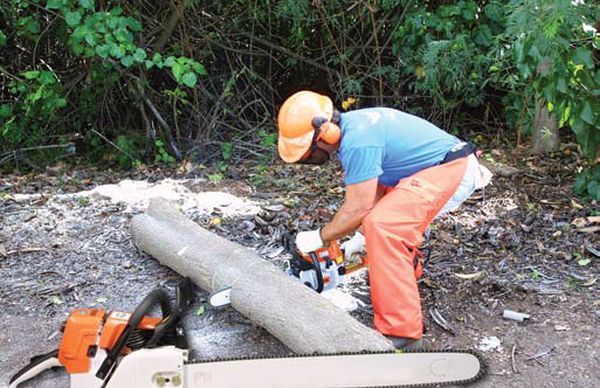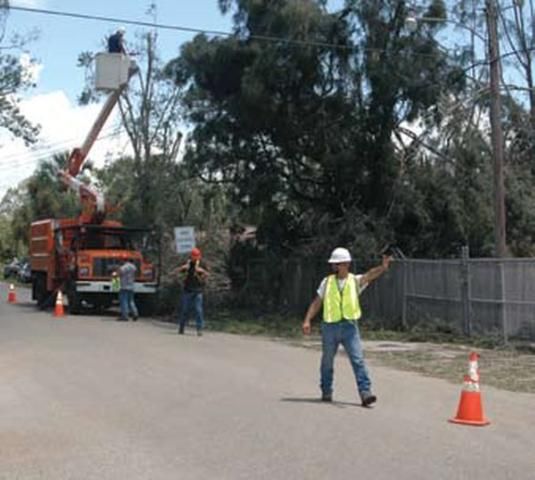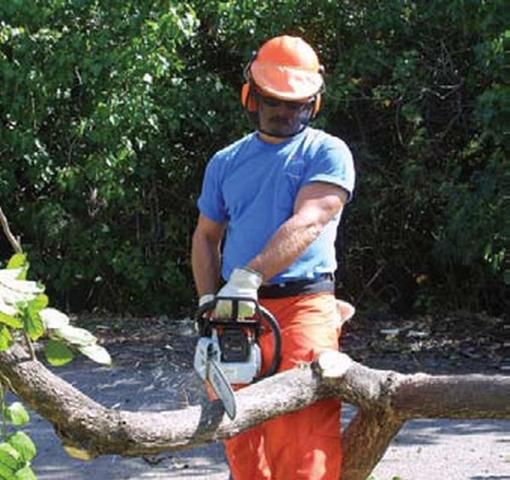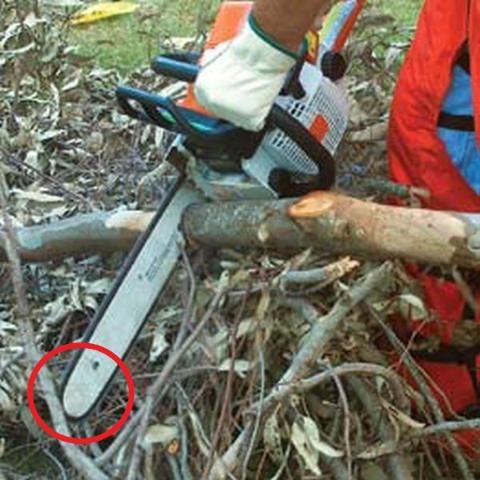
I. General Safety Tips
Do Not Work Alone
Cleanup is dangerous. Always work with a partner.
Assemble a Well-Stocked First-Aid Kit
Learn how to use it and keep it nearby.
Avoid Overexertion and Stay Hydrated
Overexertion is the most common cause for injury. Avoid lifting over 50 pounds. Remember to lift with the legs and not the back and drink plenty of fluids.

Credit: 2003 Hot Pixel Press/Arbor Global LLC
Homeowner: Stay Safe!
Homeowners are seriously injured trying to do their own tree work. It is always a good idea to consult a professional before undertaking any major restoration or removal. Professional tree workers are required by law to wear personal protective equipment: hard hat, gloves, goggles, chaps, and appropriate footwear (see the Personal Protective Equipment section). If you decide to do some of the cleanup yourself, remember to follow these guidelines:
-
Do not use a chain saw if you are not experienced in operating it or if you are not physically fit.
-
If you must use a chain saw, work only on the ground.
-
Never do any tree work that involves felling trees, climbing of any kind, or using ropes. Get a professional to help you with these situations.
II. Create a Safe Work Zone
Survey the Site
Identify potential hazards and discuss where there is potential for injuries. Agree on communication signals before you start to work.
Mark a Perimeter Around the Work Area
Use tape or cones to mark an area that is two times the height of the tree and keep non-workers safely outside this area. More distance is required when felling trees or dropping limbs.

Stay Away from Downed Power Lines
Call a professional to verify that the lines are not transmitting electricity.
III. Chain Saw Safety
Chain saws are considered the most dangerous hand tool available. The risk of injury increases during hurricane cleanup when chain saws are widely used to remove trees and branches. Use these guidelines to avoid injuries:
Keep Both Hands On the Handles
Many chain saw injuries affect the hands and are the result of using the saw with just one hand.
Follow Manual Instructions Carefully
This will ensure safe operation and proper equipment maintenance.
Take the Time to Do the Job Right
Most injuries affect the legs and feet and are the result of aggressive or careless cutting. Take breaks when needed, because most injuries occur when workers are fatigued.
Wear the Appropriate Personal Protective Equipment
Appropriate equipment includes: protective glasses and face shield, protective head gear, hearing protection, gloves, leg chaps, heavy work boots (see Personal Protective Equipment section for details).
Cut At Waist Level or Below
Chain saw injuries to the head often result from making overhead cuts (Figure 3).

Credit: 2003 Hot Pixel Press/Arbor Global LLC
Take Extra Care When Cutting Limbs
Limbs that are bent, twisted, or caught under another object may snap back and hit you or pinch the saw.
Shut Off Equipment
Turn off chain saw when fueling it, carrying it a distance of more than 100 feet, or carrying it through slippery areas or heavy brush.
Be Sure the Chain Saw Operator Is Aware of Your Presence Before You Approach
Chain saw operators often cannot see or hear the approach of other people.
Do Not Cut with the Upper Tip of the Chain Saw
Kickback occurs when the upper tip of the guide bar contacts an object and causes the saw to come straight back at the operator. It happens so fast that there is no time for reaction.
To prevent kickback, cut with the part of the bar closest to the engine. Watch where the tip is at all timesâ€"do not let it contact the ground or other branches (Figure 4).

Credit: 2003 Hot Pixel Press/Arbor Global LLC
IV. Personal Protective Equipment
The correct use of the personal protective equipment reduces the likelihood of injury by covering key areas of the body.

Credit: 2003 Hot Pixel Press/Arbor Global LLC